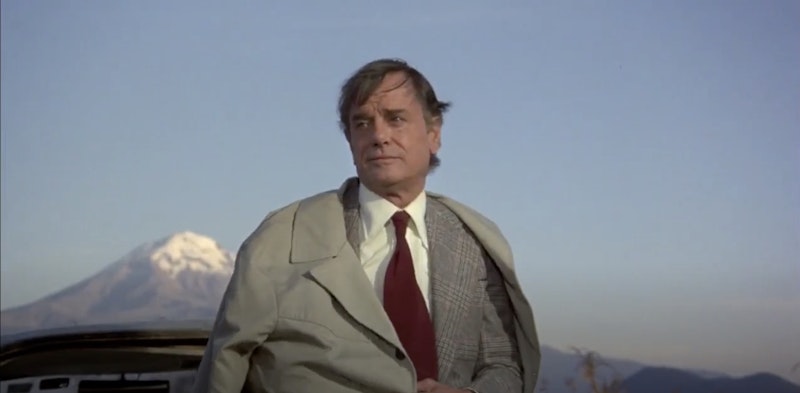One doesn’t have to look back very far or wide to find casualties of the entertainment industry in this country—usually they overdose, and whether or not it’s a surprise (or an accident) determines how they’ll be viewed for all of posterity. Suicides are common too, but there aren’t many murder-suicides in Hollywood history. Besides receiving an Oscar for Best Supporting Actor in 1970 for his performance as M.C. Rocky in They Shoot Horses, Don’t They?, Gig Young has that ignominious fact stamped on his biography and body of work. On October 19, 1978, Young shot his fourth wife in the back of the head and then blew his own head off in their Manhattan apartment. Sam Peckinpah gave him the gun.
I first noticed Young in Peckinpah’s Bring Me the Head of Alfredo Garcia, where he plays one-half of an ambiguously gay duo that show up a few times to get in the way of Warren Oates and Mr. Garcia’s head. They’re not in the movie much, but Young’s performance, although brief, is exhilarating, sensual, funny, a bit queer, and totally fucking evil. After Oates confers with Robert Webber in code on the side of a rural Mexican road in front of a huge family that “They’re going to have to take [the head from him],” Webber laughs and repeats it to Young, who looks at Webber with these huge, glistening eyes, a burning euphoria in him. What’s under his coat?
Young takes out a submachine gun and mows down an entire family before getting shot by a gang member up on a hill. We see this all through Peckinpah's virtuosity, a glorious montage of slow-motion death that ends with Young and Webber dead. But when they pull up, Young gets out and savors this air—he knows it’ll probably be his last. Like Peckinpah himself, Young’s character in this movie approaches his own death with the serenity and excitement of making love. It’s sensual, and the way Young looks at Webber after the latter says they’re “going to have to take it” has more lust and desire in it than in any of the films Young made during his salad days, if he ever really had any.
"Whenever you play a second lead and lose the girl, you have to make your part interesting yet not compete with the leading man. There are few great second leads in this business. It's easier to play a lead—you can do whatever you want. If I'm good it always means the leading man has been generous.” That’s Young talking to the Los Angeles Times in 1966, after he’d lost the Best Supporting Actor Oscar twice: first in 1953 for Come Fill the Cup, and again in 1958 for Teacher’s Pet. By the time he won for They Shoot Horses, Don’t They?, he told the press at the Kodak Theater that he was happy he won “because with all the new pictures, I figured this was my last chance.” And it was: he never got a major starring role, and in every movie he made after 1970, he’s completely loaded. It helps.
Young’s one of the only actors I can think of who looks completely different in the last decade of his life. Not just aging—maybe plastic surgery, or the booze?—this is a different actor. That LA Times quote is pretty sad, because pretty much every leading man and woman got there by upstaging and maneuvering around other people. Young played the game his whole life and ended up feeling like a failure after finally winning an Oscar. Hollywood was done with him: dependable Gig Young, born Byron Barr but forced to change his name to avoid confusion with another actor, and even more humiliatingly, because people came out of a test screening of a movie where he played a character named “Gig Young” and got raves on all the cards. Barr had “some hesitancy... but I weighed the disadvantages against the advantages of having it stick indelibly in the mind of audiences. There'd be no confusion with some other actor called Gig.” No wonder he started drinking too much.
I like Young a lot in That Touch of Mink and Teacher’s Pet, two of his favorite roles. He’s a bit more loose and has far more screen time (especially in That Touch of Mink), but it’s not until he starts drinking on the job that things get interesting. I don’t know how to explain it, but along with the alcoholic cheek drooping, his eyes get bigger, and in a movie like The Hindenburg from 1975, he’s got the same queer swagger that he had in Alfredo Garcia and The Killer Elite. His final film, Game of Death, is a sleaze-fest, not only because of its hodgepodge Bruce Lee footage (and Colleen Camp’s theme song, ripped completely from the fourth movement of Mahler’s Fifth Symphony), but Young’s dead man walking pose. The murder-suicide doesn’t seem surprising when you watch his 1970s movies.
But what drove him to that, the big orgasm? He made his own movie: a lifetime of stepping aside and expecting a favor in return, but like a fool, always falling for it. He was 64 when he died, but looked younger—if he could stand up, he was better loaded, and he could’ve made a few more movies and maybe died like William Holden, alone in his apartment with a gash on his head and an empty bottle by his side. But killing your social-climbing fourth wife three weeks after marrying her and then yourself overshadows everything. All of his nice, sweet films with Doris Day, Clark Gable, Spencer Tracy, and Katharine Hepburn gained a patina of evil that day, and Peckinpah’s films grew stronger. That shootout in Bring Me the Head of Alfredo Garcia is disturbing but beautiful, too: this was the kind of movie Gig Young should’ve been in all along.
—Follow Nicky Smith on Twitter: @nickyotissmith

